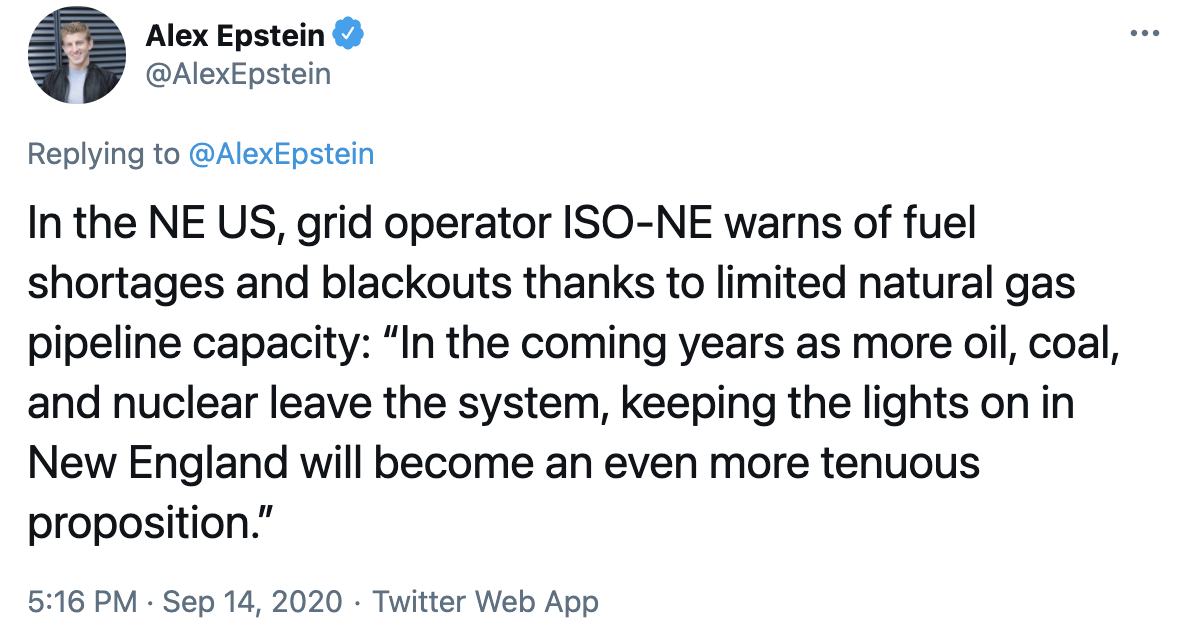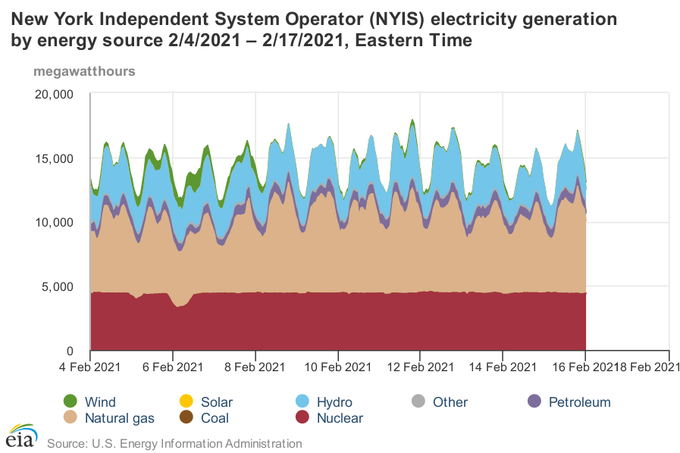Q: Is the solution to TX's reliability problems to join the national grid and be regulated by the Federal government?
A: No, because the Federal government is pursuing policies that are *even more anti-reliability than TX's*. The solution is pro-reliability policies.
-
Many say the problem causing the massive TX blackouts is TX's insistence on being an independent grid, depriving it of ample power from local states as well as wise regulation from the Federal government. But joining today's Federal grid would make TX's problems far worse.
-
Texas is perfectly capable of having an ultra-reliable grid on its own. It is the size of a fairly-large country. Any weather challenges it has faced or will face have been easily dealt with by grids around the world using reliable and resilient nuclear, coal, and gas plants.
-
Not only this specific crisis but also many near-misses TX has been having over the past decade+ are due to insufficient investment in reliable, resilient power generation--because TX was obsessed with maximizing unreliable wind/solar electricity.
-
TX's anti-reliability practices are due to a combo of federal and state *anti-reliability policies*: massive federal subsidies for wind/solar, state utility payment policies that favor wind/solar, and a state policy of keeping a low "reserve margin"--the margin for error.
-
One TX anti-reliability policy is having an "energy-only market" that pays 0 for reliable "capacity." "Legislators have shown strong support for the energy-only market that has...[made] Texas the national leader in installed wind generation." -TX official
Flexibility Without a Capacity Market: What Texas Can Teach the UK1 -
But even if Texas could have an ultra-reliable grid on its own, isn't it still a great idea to connect it to the ample generation of its neighbors? No, because not only is that generation not ample, it comes at the cost of joining an increasingly anti-reliability national grid.
-
States around Texas do not have abundant power generation that could have saved it in this crisis. All its neighbors combined generate <60% what TX does, and during this cold spell most were struggling on their own because they, too, are underinvested in reliable power.2
-
If the national grid had pro-reliability policies, there could be some modest benefits from joining it. But today's national grid has many anti-reliability policies that make possible reliability debacles in CA and other states--and those policies are getting far worse.3
-
If federal regulation under FERC functioned well, the electricity debacle that is my home state of CA would not be possible. We have shut down reliable power plant after reliable power plant, becoming more dependent on the weather and other states--all with FERC's blessing.4
-
FERC has been overseeing a national trend of shutting down reliable power plants and building unreliable ones--in which grid after grid, from NE to the Midwest to CA, is warning us that they may not be able to provide reliable power the way they used to.5

-
Ominously, FERC under Joe Biden is being directed to pursue the insane "carbon neutral by 2035" goal using almost exclusively wind and solar--the same wind and solar that just failed to provide significant power in cold regions throughout the country.6

-
Joining the national grid under Federal regulation would dramatically compound TX's problems by subjecting it to Biden administration anti-reliability policies that would have blacked out the entire state 24/7 during this cold spell when wind and solar virtually disappeared.
-
Instead of multiplying its problems by adopting worsening Federal regulations, TX should learn from its mistakes and become a pioneer in pro-reliability, pro-resiliency, pro-affordability state policy.
-
One key thing TX lawmakers need to realize is that the TX grid is not "deregulated." TX electricity is a government monopoly, whose so-called "deregulation" is actually *anti-reliability regulation* that pays the same for unreliable electricity as for reliable electricity.
-
The guiding principle for pro-reliability policies should be "long-term system cost analysis." That means that grid operators must make purchasing and payment decisions based on what mix of sources will provide highly reliable, resilient electricity at the lowest cost.
-
When grid operators make decisions based on "long-term system cost analysis" instead of seeking to use as much wind/solar as possible, they inevitably choose and properly maintain reliable sources like nuclear, coal, and natural gas. This is a winning formula.
-
Policymakers who care about lowering CO2 emissions should recognize that today's Federal and State anti-reliability policies--such as subsidies for wind/solar and targets for "renewables"--increase emissions by shutting down nuclear plants, which are closing in record numbers.7
-
If TX commits to reliability and starts using long-term system-cost analysis it can not only bring TX a bright electricity future, it can be a model for the rest of the country. We need that model more than ever as the Biden administration tries to nationally mandate unreliables.
References
- In Texas, the grid’s reserve margin—the amount of capacity it has above expected peak demand—has shrunk so much that the Public Utilities Commission of Texas called the situation “very scary.”
Utility Drive, January 22, 2019↩ - TX’s neighboring states are New Mexico, Oklahoma, Arkansas, and Louisiana with combined generation of 285 TWh in 2019, 59% of what’s generated in TX. Even with enough transmission capacity, this is a big gamble as a backup even if they don’t suffer their own weather problems.
U.S. Energy Information Administration - Electric Power Annual↩ - Most states have Renewable Portfolio Standards, which effectively demand more solar and wind on their grids by law. U.S. Energy Information Administration - Renewable energy explained, Portfolio standards↩
- Talking Points on California Blackouts↩
- AP - Fuel constraints could hit New England grid by 2024↩
- “The five-member Federal Energy Regulatory Commission is poised to play a pivotal role fulfilling Biden’s clean-energy ambitions, including his vow to strip greenhouse gas emissions from the power sector over the next 14 years. FERC could help Biden deliver on those promises by fostering carbon prices on electricity, propelling a massive build-out of high-voltage power lines and making it harder to build natural gas pipelines.”
Bloomberg - Biden's Secret Weapon to Cleaning Up Energy Is Spelled FERC
U.S. Energy Information Administration - Hourly Electric Grid Monitor↩ - U.S. Energy Information Administration - Nuclear and coal will account for majority of U.S. generating capacity retirements in 2021↩
